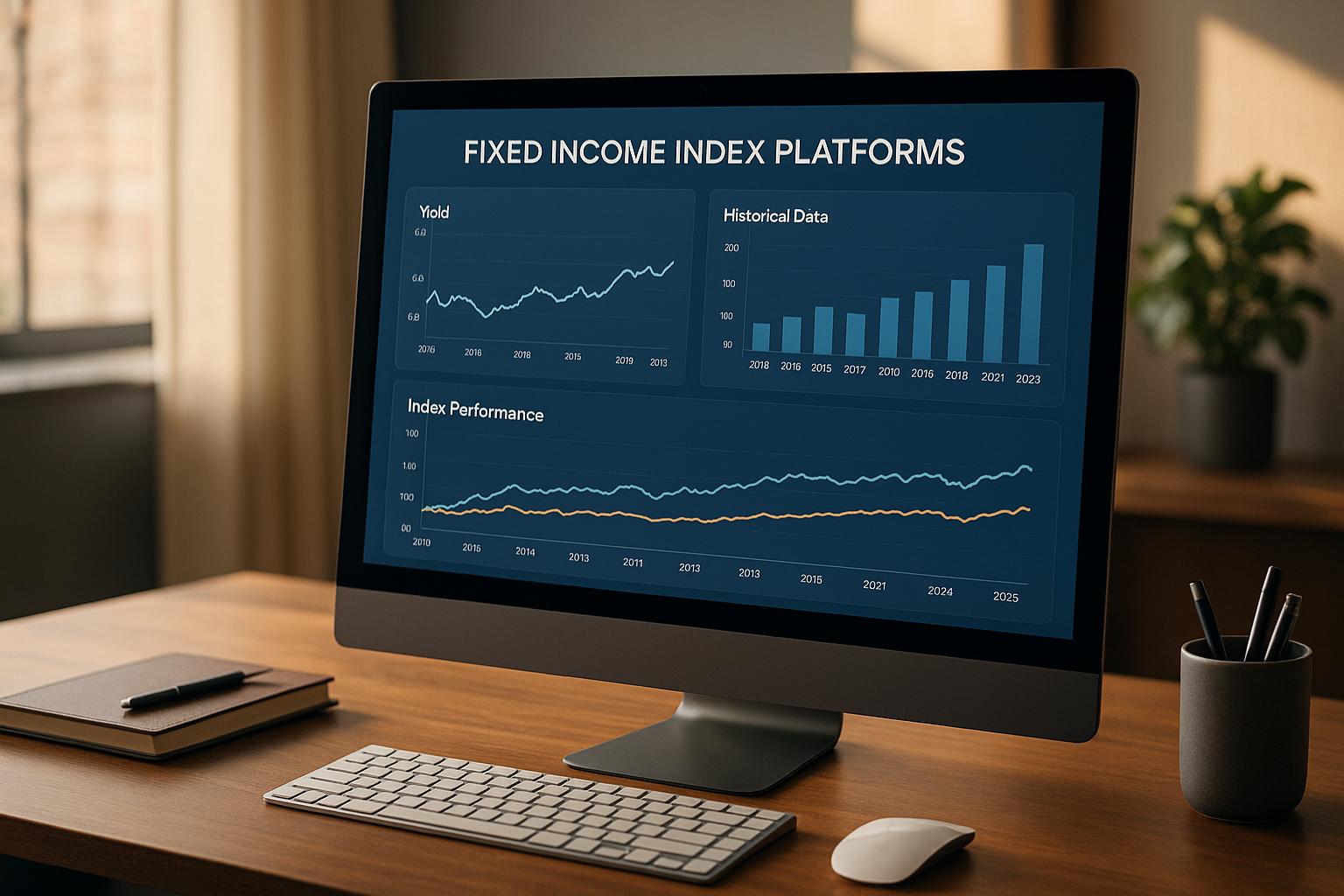Multi-asset attribution tools analyze portfolio performance across asset classes like equities, bonds, and alternatives. They break down returns into factors such as allocation, selection, and timing, helping investors understand what drives gains or losses. Here’s what you need to know:
- Methods: Tools use holdings-based, transaction-based, or returns-based approaches depending on data availability and portfolio complexity.
- Key Metrics: Metrics include allocation, selection, and interaction effects, with some tools also factoring in currency impacts.
- Top Tools: Platforms like MSCI’s Multi-Asset Class (MAC) model provide detailed insights for institutional and individual investors.
- Benefits: These tools simplify performance analysis, improve decision-making, and enhance communication with stakeholders.
Whether managing a low-turnover portfolio or an active strategy, these tools are essential for breaking down performance and refining investment strategies.
Performance Evaluation 6: An Attribution Analysis Example, and the Interaction Effect
Core Methods of Multi-Asset Attribution
Multi-asset attribution analysis revolves around three primary methodologies. The choice of method hinges on the available data, the complexity of the portfolio, and the level of detail required for informed investment decisions.
Holdings-Based Attribution
Holdings-based attribution evaluates portfolio performance by focusing on the positions held at the start of a measurement period. Essentially, it attributes returns to the portfolio's initial allocations. For example, if a portfolio begins January with 60% in U.S. equities and 40% in bonds, this method evaluates monthly returns based only on these starting positions. However, it has a notable limitation - it doesn't account for any transactions made during the period.
This method works well for U.S.-based portfolios with low turnover, offering a practical mix of simplicity and insight. It provides more granularity than returns-based approaches while avoiding the complexity of tracking every trade.
Transaction-Based Attribution
Transaction-based attribution takes a more detailed approach by incorporating both the portfolio's holdings and all transactions - purchases and sales - made during the evaluation period. It assesses the real-time effects of investment decisions. For instance, if a portfolio manager shifts investments from technology stocks to healthcare mid-month, this method evaluates how those trades and their timing impacted overall performance, factoring in the exact dates, cash flows, and changes in positions.
This level of precision comes with added complexity. It requires accurate and reconciled data from multiple sources, including details on timing, prices, and trade quantities. Despite the challenges, it's especially valuable for institutional investors managing active multi-asset portfolios, where understanding the exact drivers of performance is critical.
Returns-Based (Factor) Attribution
Returns-based attribution takes yet another approach by analyzing total portfolio returns rather than specific holdings or transactions. Using statistical factor models, it breaks down returns into components like market exposure, value tilt, growth bias, or sector concentration. For example, if a portfolio achieves a 12% return compared to a 10% benchmark return, this method might attribute the difference to factors such as small-cap exposure or a preference for value stocks.
While this method is the simplest to implement, it is also the least precise. It infers performance drivers based on return patterns rather than concrete data. This approach is particularly helpful in cases where detailed portfolio data is unavailable, such as with hedge funds or private equity investments.
Each method offers a unique lens for examining portfolio performance, suited to varying levels of data availability and portfolio strategies. The table below summarizes the key aspects of these methods:
| Method | Data Requirements | Accuracy Level | Implementation Complexity | Best Use Cases |
|---|---|---|---|---|
| Holdings-Based | Beginning-of-period positions | Moderate (better with shorter intervals) | Medium | Passive strategies, low-turnover portfolios |
| Transaction-Based | Holdings plus complete trade data | Highest | Most complex | Active management, detailed analysis |
| Returns-Based | Total portfolio returns only | Lowest | Easiest | Limited data scenarios, hedge funds, private equity |
The choice of method ultimately depends on the investor's data access, portfolio complexity, and the depth of analysis required. Together, these approaches form the foundation for understanding performance attribution in multi-asset portfolios.
Key Metrics in Multi-Asset Attribution
Multi-asset attribution breaks down portfolio returns into essential components, enabling investors to identify what drives performance. The Brinson-Fachler model is a widely used framework that separates returns into three main effects: allocation, selection, and interaction. For U.S. investors, these metrics are crucial tools for analyzing multi-asset portfolios and refining investment strategies. Let’s explore these components in more detail.
Allocation Effect
The allocation effect evaluates the impact of overweighting or underweighting asset classes compared to a benchmark. For instance, if a portfolio manager allocates 50% to U.S. equities while the benchmark holds 40%, and U.S. equities outperform, this decision adds positive value.
For U.S. investors, allocation effects often arise in scenarios like favoring domestic equities or tilting toward high-growth sectors, such as technology, during favorable conditions. For example, if a manager increases the tech sector allocation to 50% versus a benchmark weight of 30%, and the sector outperforms, this shift generates a positive allocation effect.
Selection Effect
The selection effect focuses on the impact of choosing specific securities or investments within an asset class or sector. While the allocation effect answers the question of "where" to invest, the selection effect deals with "what" to invest in within those chosen categories.
For example, if a manager selects tech stocks that deliver a 15% return compared to the sector average of 12%, their stock-picking decisions have added value. This effect highlights the importance of security selection in driving portfolio performance.
Currency and Interaction Effects
The interaction effect examines how allocation and selection decisions work together to influence performance. It reflects the combined impact of these decisions, which may either amplify or offset each other.
"The interaction effect combines the selection and allocation effects. It is not easily attributable to a single decision because it arises from the way these effects mathematically interact."
"In practice, decisions aren't always made in isolation. Often, a manager's performance is influenced by how they combine allocation and selection decisions. This is where the interaction effect comes into play." - Janko Sikošek, Quantitative Analyst, Kiski
For example, if a manager overweights the tech sector and also selects stocks within the sector that outperform, the interaction effect enhances overall performance. On the other hand, if these decisions conflict, the interaction effect could detract from returns.
In global portfolios, currency movements add another layer of complexity to attribution analysis. Exchange rate fluctuations can significantly impact returns, refining the overall attribution picture.
sbb-itb-2e26d5a
Top Multi-Asset Attribution Tools
MSCI Multi-Asset Class (MAC) Performance Attribution

The MSCI Multi-Asset Class (MAC) Factor Model is designed for institutional investors managing diverse portfolios. It offers a unified view of factor exposures across multiple asset classes, making it easier to implement factor-based asset allocation strategies. This model goes beyond equities, introducing systematic factors that help clarify the drivers of risk and return across an entire portfolio. For U.S. investors, it provides insights into the contributions of domestic equities, international bonds, and alternative investments.
One standout feature of the MAC model is its ability to provide varied levels of detail. This flexibility allows portfolio managers to present high-level summaries to executives while enabling risk teams to dive deeper into specific factor breakdowns. Its integrated framework simplifies the communication of key exposures across different parts of an organization.
The Fixed Income Factor Model within MAC is particularly robust, covering over 950 factors, including term structure, break-even inflation, credit, swap, and sovereign spread factors. This comprehensive factor library ensures that U.S. investors can analyze their bond portfolios with the same level of precision as their equity holdings.
"The ability to leverage MSCI factor models directly from Charles River IMS provides an enterprise-scale solution that helps facilitate collaboration between portfolio and risk managers, helps speeds time to critical information and helps enhance productivity by providing a single desktop for managing portfolio construction, scenario analysis and risk forecasting."
– Charles River Development
Tool Feature Comparison
When selecting multi-asset attribution tools, U.S. investors should consider several key features that influence both the quality of analysis and operational efficiency:
| Feature | MSCI MAC | Considerations |
|---|---|---|
| Asset Class Coverage | Equities, Fixed Income, Alternatives | Ensure it includes U.S. domestic markets, international investments, and alternatives |
| Factor Granularity | 950+ fixed income factors, equity factors | Look for detailed factor insights that align with your portfolio strategy |
| Integration Capabilities | Charles River IMS integration | Check compatibility with your existing portfolio management systems |
| Reporting Flexibility | Multiple granularity levels | Useful for tailoring reports to executives, risk teams, and clients |
| U.S. Market Focus | Global coverage with U.S. depth | Ensure comprehensive coverage of U.S. sectors, styles, and market segments |
Additionally, evaluating IBOR capabilities and cost transparency is crucial for maintaining accurate portfolio views and avoiding unexpected expenses as portfolios grow.
Benefits for U.S. Investors
For portfolio managers in the U.S., these tools provide three main advantages: better transparency, enhanced risk management, and simplified compliance reporting.
Better transparency comes from the ability to view systematic strategies across asset classes. Instead of analyzing each asset class separately, these tools offer an integrated perspective, showing how different investments interact to drive overall performance. For example, U.S. investors can assess whether their international equity allocation is genuinely diversifying their portfolio or merely adding correlated risk.
Enhanced risk management is achieved through factor-based asset allocation. By identifying the factors influencing performance across the portfolio, investors can make more informed decisions about hedging strategies and position sizing - especially when managing currency risks in international assets.
Simplified compliance reporting addresses the increasingly stringent regulatory requirements faced by U.S. institutional investors. These tools help deliver clear, detailed insights into portfolio exposures, supporting fiduciary responsibilities and improving investment committee discussions with data-driven insights.
User satisfaction with these tools has seen a significant jump - from an average score of 5/10 to 8.8/10 - after adoption. This improvement underscores their practical value in streamlining portfolio management.
For more details and reviews of multi-asset attribution tools, visit Best Investing Tools Directory.
How to Use Attribution Tools in Practice
Building on the metrics and methods discussed earlier, applying attribution tools in real-world scenarios helps uncover the key drivers behind portfolio performance.
Finding Portfolio Performance Drivers
Multi-asset attribution tools are invaluable for identifying how active management influences performance beyond market-driven factors. For instance, a global equity fund manager using holdings-based attribution might find that their fund's outperformance is largely due to an overweight position in the technology sector.
"Performance attribution is a powerful tool that helps us understand the drivers of our portfolio's returns. By analyzing the specific securities and sectors that contributed to our performance, we can refine our investment strategy and make more informed decisions." – John Doe, Portfolio Manager
These tools quantify how active decisions contribute to excess returns. To achieve this, investors often rely on Brinson models and factor-based analyses that account for elements like yield, duration, credit quality, currency adjustments, and trading effects.
Improving Investment Decisions
Attribution analysis takes raw performance data and translates it into actionable insights. By evaluating fund manager strategies, identifying sources of alpha, and tracking style drift, this process enables managers to refine their approaches. It creates a feedback loop that helps dissect individual investment decisions, highlight areas for improvement, and adjust overall strategies.
For U.S.-based portfolios, these tools are especially helpful in managing currency risks. They provide clarity on how allocation choices and instrument selection impact hedging and currency exposure. Performance attribution also helps distinguish a fund manager's strategy by pinpointing success drivers and supporting detailed factor analysis. However, challenges remain - 52.9% of multi-asset managers report difficulties in managing unique data requirements and large volumes of information.
Reporting and Stakeholder Communication
Attribution tools simplify complex performance data, turning it into clear and accessible reports for stakeholders. These reports improve transparency around portfolio performance and demonstrate return on investment across various channels. Such clarity is crucial for justifying budgets, securing additional investments, and building trust with stakeholders.
Yet, communication hurdles persist. In the U.S., 47.1% of investment managers struggle to align attribution outputs with diverse stakeholder expectations, while 41.2% face challenges in delivering timely, actionable insights to clients. Attribution tools bridge these gaps by providing a unified view of data, fostering collaboration across portfolio, risk, and management teams. This allows them to evaluate the effectiveness of specific asset classes, strategies, and portfolio segments.
When presenting attribution results, managers should use straightforward language, offer context, and incorporate visual aids to highlight each asset class's contribution to overall performance. To enhance reporting, investment managers are encouraged to use tools with intuitive dashboards and invest in training to turn insights into actionable strategies. This approach ensures that reporting aligns with earlier analyses, providing a cohesive view of portfolio performance.
Conclusion
Multi-asset attribution tools have transformed how portfolio performance is analyzed, offering managers and institutional investors a deeper understanding of returns. By breaking down complex return patterns into actionable data, these tools empower smarter investment decisions.
Key Takeaways
The strength of multi-asset attribution lies in its ability to help investment strategies stand out in today’s competitive market. Alexander Rudin, Ph.D., Global Head of Multi-Asset and Fixed Income Research at State Street Global Advisors, emphasizes this point:
"As asset managers, we exist to help investors meet their objectives. Such objectives vary widely, and so do metrics we use to assess success of our work".
For U.S.-based portfolios, these tools offer three major benefits:
- Deeper insights into performance: They go beyond surface-level metrics to uncover the real drivers of portfolio returns.
- Transparency and accountability: By evaluating the manager’s process, they ensure risk-conscious strategies are implemented effectively.
- Benchmark comparisons: They allow managers to highlight their investment style and historical performance relative to benchmarks, reinforcing their value to stakeholders.
Understanding these methods underscores the importance of informed and proactive portfolio management. For institutional investors, attribution tools are essential for standing out in a market where passive strategies dominate. They provide the evidence needed to justify active management fees and build investor trust.
Next Steps for Investors
To fully benefit from these tools, investors should take a strategic approach to integrating multi-asset attribution into their processes. Start by identifying the most suitable multi-asset strategy for your portfolio. This involves assessing your risk tolerance, investment objectives, and time horizon. While these strategies offer flexibility and diversification, their success relies on careful execution and ongoing evaluation.
Consider using asset allocation calculators to set clear benchmarks. Explore whitepapers and consult with specialists to identify the best tools for your specific needs. Many providers offer demonstrations and consultations to help you choose tools that align with your reporting and stakeholder requirements. Antti Ihalainen, Head of Middle Office at Varma, shared his experience with attribution tools:
"With PEARL, we've gained invaluable insights into our investments, streamlined our investment portfolio reporting, and have become more adaptable for any possible future changes in our investment processes".
Stay updated by engaging with industry publications and attending conferences that focus on multi-asset strategies and performance measurement. As methodologies and technologies continue to evolve, they offer new ways to strengthen your analysis and decision-making.
Ultimately, successful attribution analysis isn’t just about tracking performance - it’s about creating a feedback loop that refines your investment strategies over time. With disciplined research and strong infrastructure, you can improve outcomes for your stakeholders and achieve greater long-term success.
FAQs
How can I select the best multi-asset attribution method for my portfolio's complexity and available data?
Choosing the best multi-asset attribution method boils down to understanding your portfolio's structure and the quality of your data. If your portfolio is complex, with multiple layers or diverse asset classes, you might need advanced attribution models that can handle hierarchical structures. For simpler portfolios, basic methods focusing on asset allocation and security selection might do the job just fine.
The quality and detail of your data also matter a lot. Detailed, high-quality data enables more precise and in-depth analysis. On the other hand, if your data is limited or less granular, you may need to take a broader, less detailed approach. The key is to match the attribution method to both your portfolio's complexity and the resources you have available to ensure you get meaningful performance insights.
What’s the difference between allocation, selection, and interaction effects in performance attribution?
The allocation effect examines how the portfolio's mix of assets stacks up against its benchmark. It reveals if decisions to overweight or underweight specific asset classes contributed positively to performance.
The selection effect focuses on how well individual investment choices within those asset classes performed, showcasing the manager's ability to pick winning stocks or securities.
The interaction effect looks at how allocation and selection decisions work together. For instance, if both allocation and selection exceed expectations, the interaction effect is positive. On the flip side, if they fall short when combined, the interaction effect turns negative. Together, these three effects provide a clear picture of portfolio performance and pinpoint areas that might need fine-tuning.
How do multi-asset attribution tools help improve investment decisions and communication with stakeholders?
Multi-asset attribution tools offer key insights into how portfolios perform, breaking down which assets, strategies, or decisions are contributing the most to returns. By evaluating performance across various asset classes, these tools empower investors to make smarter decisions, manage risks effectively, and allocate portfolios more strategically.
They also simplify communication with stakeholders by producing detailed, easy-to-understand reports that showcase performance attribution. This level of clarity builds trust and accountability, making it much easier to explain results and justify investment choices to clients, team members, or other stakeholders.



